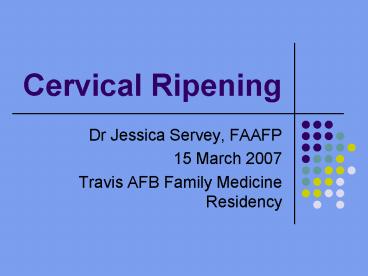Cervical Ripening - PowerPoint PPT Presentation
1 / 20
Title:
Cervical Ripening
Description:
Review the indications for cervical ripening. Review the mechanical means of ... 2005 (extra amniotic saline infusion) No difference in vaginal delivery rates ... – PowerPoint PPT presentation
Number of Views:1018
Avg rating:3.0/5.0
Title: Cervical Ripening
1
Cervical Ripening
- Dr Jessica Servey, FAAFP
- 15 March 2007
- Travis AFB Family Medicine Residency
2
Objectives
- Review the indications for cervical ripening
- Review the mechanical means of cervical ripening
- Look at pharmacologic for cervical ripening
- Consider risks and benefits of agents
3
What is cervical ripening
- Process that is used to soften, dilate and efface
the cervix - Agents will often start labor
4
Indications
- Postterm
- Hypertensive disorders
- Premature rupture of membranes
- Chorioamnionitis
- IUGR
- Isoimmunization
- Intrauterine fetal death
- Maternal medical complications
- Logistic factors
5
Contraindications
- ABSOLUTE
- Placenta previa
- Vasa Previa
- Transverse/breech lie
- Prolapsed cord
- Prior classical c-section
- Active genital herpes
- RELATIVE
- Multifetal gestation
- Polyhydramnios
- Maternal cardiac conditions
- Grand multiparity
- Presenting part not in fetal pelvis
6
Bishop score
- Described 1955
- Score at least 8 induction chances of vaginal
delivery - equivalent to spontaneous
- ACOG recommends score at least 6 for induction
7
Methods to ripen
- Mechanical
- Laminaria
- Dilators
- Foley balloon
- Membrane stripping
- Acupuncture
- Pharmacologic
- Prostaglandin (Prepidil/Cervidil)
- Misoprostol
- Pitocin
8
Mechanical Methods
- Laminaria
- Efficacious in cervical dilation
- Increased risk of intrauterine infection third
trimester - Hygroscopic cervical dilators
- Cheap
- Easy to place
9
Mechanical Methods
- Membrane stripping
- Cochrane review of 19 trials, 17 compared with
placebo - NNT 7 to avoid one formal induction past 40 weeks
- No risk of infection
- Acupuncture
- LI4 and Sp6 can aid in cervical ripening
- Study demonstrated shortened interval to delivery
10
Foley balloon
- First described in 1967
- Safe
- Cheap
- Easy to use in combination with pitocin
- May be useful for outpatient ripening
11
Foley Balloon
- 2004 (30 vs 80 ml)
- 75 in 80ml group vs 58 in 30ml deliver within
24 hours - c-section rate not significant
- 2005 (extra amniotic saline infusion)
- No difference in vaginal delivery rates
- No difference in maternal or fetal complications
12
Cervidil/Prepidil
- PGE2
- 3 methods of action
- Alters extracellular ground substance
- Affects smooth muscle of the cervix
- Gap junction formation
- Meta analysis of more than 7 studies show
efficacy compared to placebo or oxytocin - Storage/cost/user capability are issues
13
Cervidil Placed in posterior vaginal fornix
Prepidil Intracervical placement
14
Low dose pitocin
- 1 to 4 mu per minute for ripening
- 2002 study compared this to cytotec 50 ucg dose
- Interval to delivery - significantly less with
cytotec - Vaginal delivery 61 vs 65 (no difference)
- Cytotec higher c-s for fetal distress (27 vs 8)
- Pitocin higher c-s for labor dysfunction (26 vs
10) - Overall- same efficacy
15
Misoprostol
- Dosing
- 25 mcg
- 50 mcg
- Intravaginal
- Oral
- Very cheap
- Easy to store
- NOT FDA APPROVED
16
Misprostol 25 vs 50 ucg dose
- 50 ucg increase rate of vaginal delivery
- Shorter time to delivery
- Increased fetal distress related to uterine
hyperstimulus - Cochrane review with increased need for oxytocin
with 25 but less uterine problems (NNT 25) and
trend toward less neonatal ICU admissions - Individual studies show differences in c-section
rates
17
Oral vs vaginal
- Study published 2005
- 212 women
- No statistical difference between time of first
dose to time of delivery - Pitocin used in 97 of both groups
- No difference in maternal complications, fetal
complications, or side effects - No difference in indication for c-section
- Dosing
- 25 ucg vaginally every 4 hours vs 50 ucg followed
by 100 ucg orally every 4 hours
18
Which is better?
- Study 2003 Cervidil vs cytotec (both had
pitocin) - Time to vaginal delivery not significant
- C-section rate not significant
- Reasons for c-section essentially the same
- Cochrane review
- Subgroup analysis with significantly larger of
patient deliver within 24 hr with cytotec (nnt
10) - No change in c-section rate for PGE1 vs 2
19
How to choose?
- Cost effectiveness
- Cervidil and prepidil vs cytotec and Foley
balloon - Cost of nursing staff
- ? Outpatient regimens
- How long must use pitocin
- Patient choice
- Only safety contraindicationPrior c-section
- Increased risk of uterine rupture using
prostaglandins to ripen cervix for VBAC
20
References
- Colon et al, Prospective Randomized Clinical
Trial of inpatient cervical ripening with
stepwise oral misoprostol vs vaginal misoprostol,
American Journal of Obstetrics and Gynecology,
2005, 192747-752. - Cochrane database, Membrane sweeping for
induction of labor, updated 2005. - Levy et al, A randomized trial comparing a 30-ml
and a 80-ml Foley catheter balloon for
preinduction cervical ripening, American Journal
of Obstetrics and Gynecology, 2004,
1911632-1636. - Bolnick et al, Randomized trial between two
active labor management protocols in the presence
of an unfavorable cervix, American Journal of
Obstetrics and Gynecology, 2004124-128. - Weaver, Sally,Vaginal Misoprostol for Cervical
Ripening in Term Pregnancy, American Family
Physician, February 2006, Vol 733, pg 511-512. - ACOG Committee on Practice Bulletin-Obstetrics.
Induction of Labor. ACOG Practice Bulletin No.
10., November 1999. Obstetrics and Gynecology.
199994(part1) 1-10. - Lydon-Rochelle et al, Risk of uterine rupture
during labor among women with prior cesarean
delivery, New England Journal of Medicine, 2001,
3453-8. - Sanchez-Ramos, Luis, Induction of Labor,
Obstetrics and Gynecology Clinics of North
America, 2005, 32181-200.































